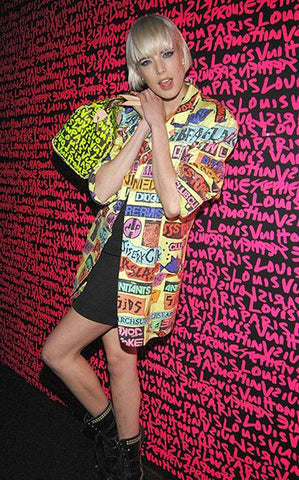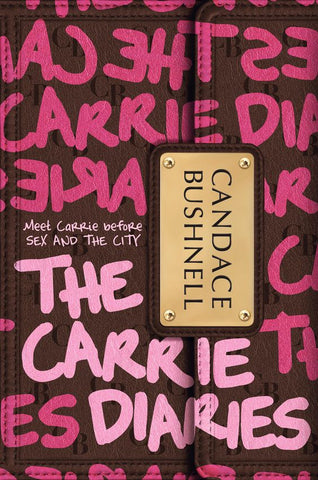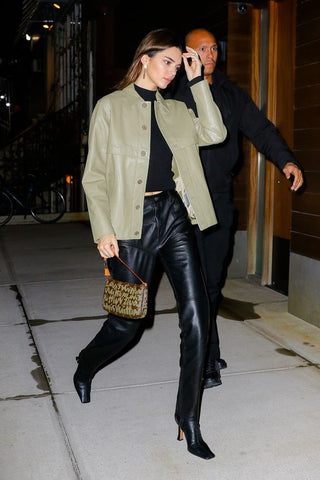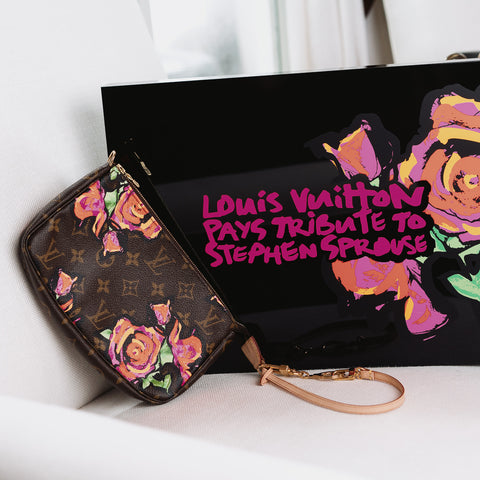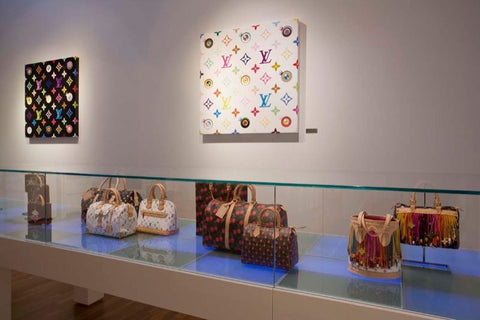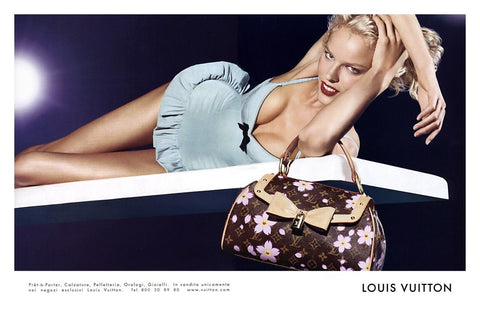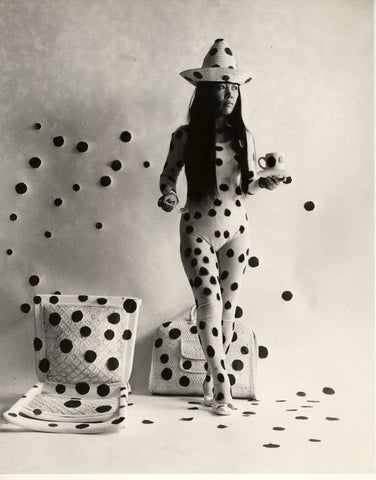The Most Influential Louis Vuitton Artistic Collaborations
In January 2023 Louis Vuitton is launching their second collaboration with a renowned Japanese artist Yayoi Kusama after 10 years of the premiere of the first one. Such artistic collaborations attract a lot of attention in both fashion and art world, as well as in the luxury consignment commerce. Louis Vuitton has established itself as a patron of the arts. The brand collaborated with the biggest names in the art world, like Jeff Koons, Cindy Sherman and Richard Prince among others. It sponsors modern art exhibitions and in 2014 opened the Louis Vuitton Foundation, an art museum and cultural centre. In this month’s blog we look back at some of the most successful and important Louis Vuitton artistic collaborations and their influence on fashion and culture.
Stephen Sprouse - Graffiti Collection (2001)
The first artistic collaboration, which blended art, fashion and commerce for the new contemporary luxury era happened when Marc Jacobs, who was the creative director of Louis Vuitton at that time, invited Stephen Sprouse to play around the iconic canvas in 2001.
Sprouse was an American designer and artist, popular in the 1980s. He started his career assisting Halston. When he launched his own company in 1983, his clothes were worn by Andy Warhol, Diana Ross, Mick Jagger and Debbie Harry of Blondie. His style was “a sort of punk couture”, mixing “uptown sophistication with downtown punk and pop sensibility” [17] .
For their collaboration with Louis Vuitton, Sprouse played with the most important and even “sacred” [1] [3] element of the brand - with its logo! He deliberately scrawled on a Louis Vuitton bag like a graffiti artist tagging a wall [3], mixing high and low, blending high-end elegance with pop culture. He also knew that his graffiti “represented the triumph of the human hand in the age of mega-corporation and mass-production” [3]. But apparently, it was Marc Jacobs, who got this idea when he saw a monogrammed trunk coated with a layer of black paint at actress-singer Charlotte Gainsbourg’s Paris apartment. [5] [16]
According to the fashion historian Olivier Saillard. “Predictably, the irreverence of this act drew astonished and scandalized reactions, but it was a strong creative breakthrough that proved very influential”. [3]
According to the book “Handbags: A Love Story” by Monica Botkier, this collaboration of Marc Jacobs with Stephen Sprouse for Louis Vuitton, was supposed to be only a runway and editorial collection. It ended up being a commercial blockbuster. [4] The graffiti motif, this time in fluorescent colours, was reissued in 2009 as a proof of its enduring popularity. The collection is remembered to be very popular with the celebrities of the time and it has become emblematic of the Y2K fashion.
This collaboration not only laid the groundwork for Louis Vuitton’s subsequent artistic collaborations but it also trickled down to the most casual area - a souvenirs marker. Marc Jacobs in one of the interviews noted an interesting fact - up to this day souvenir nylon tote bags, that say a location, like “Paris France” are written in a style, that’s imitating Sprouses’ works for Louis Vuitton in 2001. [4] [16] In addition, the cover of a book “The Carrie Diaries”, a prequel to Sex and the City about teenage Carrie Bradshaw, published in 2010, has a very similar to Louis Vuitton and Stephen Sprouse graffiti design.
In 2021 the fashion world celebrated 20 years of this collaboration, claiming that it was “one of the greatest collaborations of all times” [2] and “one of the most beloved” [7]. It is officially considered vintage now and can only be scouted on the resale platforms like Lux Second Chance. Notably, lately Kendall Jenner has been seen wearing it, increasing a demand for it for the new generations.
Stephen Sprouse - Roses (2009)
In 2004 Stephen Sprouse passed away from lung cancer. Five years after, in 2009, Marc Jacobs for Louis Vuitton presented a Tribute collection in memory of his friends and former collaborator.
The Tribute collection included the reissue of graffiti prints and introduction of leopard print, but more significantly the Roses motif, that has become very enduring. The design of the roses was sketched by Sprouse himself in 2001, but wasn’t used in the collaboration then. Roses had long been in his artistic vocabulary. He first started playing with roses in the 1970s, when he used a Xerox copier to enlarge and distort images of the flowers to incorporate into his designs. [5]
Louis Vuitton Tribute collection was timed to the opening of a Sprouse retrospective at New York’s Deitch Gallery and a release of a Sprouse's book by Rizzoli to celebrate his artistic legacy. Roses print was featured on Luis Vuitton signature handbags like Speedy, Neverfull, Alma, Pochette Accessories, as well as on shoes and clothes. Marc Jacobs designed graffiti-tagged T-shirts, leggings, jeans and the lining of a classic raincoat, and printed digitized roses on knit mini-dresses for Louis Vuitton. “I did my best, in a very first degree way, to do what I think Stephen would have done,” Jacobs said in a statement. [5]
Today it is resold on the secondary market beyond the market value and is considered one of the brand’s best collaborations [6] thanks to its timeless yet artsy look.
Takashi Murakami - Monogram Multicolore (2002)
Monorgam Multicolore Louis Vuitton by Takashi Murakami no doubt has become the symbol of Y2K fashion. It has become a part of the visual language of paparazzis who in early 2000s photographed this bag on the crook of the arms of iconic figures of the period like Paris and Nicky Hilton, Jessica Simpson, Lindsay Lohan, Lil Kim among others. This handbag exemplifies the fashion of that period, which is slowly making a comeback. Also, their partnership with the brand is significant for both the artist and the company.
Takashi Murakami was born on February 1,1962 in Tokyo, Japan. In 1994 he moved to New York and in 1996 he established an art production and artists management company called the Hiropon Factory - that sounds like a nod to the Factory of Andy Warhol. It became the precursor to his company Kaikai Kiki Co., Ltd that Murakami owns today. In 2001 he introduced the Superflat movement, a fusion of art and animation that focused in on post-war Japan, kawaii (cute) culture and became a commentary on the changes taking place in Japanese society as it hurdled towards Western consumerism. [11]
When Marc Jacobs discovered Takashi Murakami during an exhibition of his work at the Cartier Foundation for Contemporary Art in Paris in 2002, he knew he wanted to work with the Japanese artist. Launched for Spring/Summer 2003 the Multicolore Monogram line’s striking rainbow-hued print was a new and innovative take on the heritage brand’s world-famous logo.The first Murakami bags for Louis Vuitton are called Multicolore Monogram canvas, for which the artist created 33 colours, printed through 33 silkscreens, on a black and white background [3] instead of a classic brown beige logo canvas.
The logo was updated, it played around and signified a more fun approach to fashion. The collection was a smashing commercial success for Louis Vuitton and the artist. According to the fashion historian Olivier Saillard, “Louis Vuitton propelled Murakami’s international reputation”. [3] Though he had previously collaborated with fashion designers such as Issey Miyake Men by Naoki Takizawa, his work with Louis Vuitton made him widely known for blurring the line between 'high art' and commercialism. It also elevated him to celebrity status in his home country of Japan. In 2008, Murakami was named one of Time magazine's "100 Most Influential People", the only visual artist included. [10]
When Murakami held an exhibition in MOCA, the Los Angeles Museum of Contemporary Art, not only Louis Vuitton sponsored it, but they installed an actual store, that was part of the exhibition, by the invitation of the artist. That caused quite a scandal, yet Marc Jacobs called their collaboration “a monumental marriage of art and commerce”. [3]
Following the success of the Monogram Multicolore collection, Murakami continued his work with Louis Vuitton. Fun and whimsical Louis Vuitton Takashi Murakami collaborations followed, such as Cherry Blossom (2003), Panda (2004), Cerises (2005), MOCA Hands (2007 for Museum of Contemporary Art Los Angeles exhibition), Monogramouflage (2008), and Cosmic Blossom (2010). [8] Murakami’s imaginative and colourful aesthetic infused a radical, playful spirit into Louis Vuitton. [9]
However in the following decade of 2010s logomania was not as trendy, substituted by minimalistic and subtle styles of handbags, like Celine, Balenciaga and Alexander Wang. In 2015, Louis Vuitton announced that it was ending its relationship with Murakami, around the same time when Nicholas Ghesquière took over the reigns from Marc Jacobs [11]. The partnership between Murakami and Louis Vuitton was the longest artist collaboration the brand has ever had. After 12 years Monogram Multicolore line was officially discontinued.
But as the practice shows, what goes around comes around. With the nostalgia, resurgence for Y2K fashion and seeing celebrities wearing this collection, the interest for Takashi Murakami for Louis Vuitton has come back as well. His handbags are only available on the resale market today. Prices continue to increase over recent years, especially for certain popular models. Taking the Mini HL Speedy bag, loved by Kardashian-Jenner sisters, for example, the resale price has skyrocketed more than 200% in the past several years, and it still sells as soon as it hits the shelf. [8]
Yayoi Kusama - Chapter 1 and Chapter 2 (2012 and 2023)
The first collaboration between a Japanese female artist Yayoi Kusama and Louis Vuitton took place in 2012 under the creative direction of Marc Jacobs. The artist’s signature dots made it across clothing and some of the most famous Louis Vuitton silhouettes of the Keepall, Neverfull, Papillon and Speedy. To this day, pieces from the inaugural collection can be found at the premium prices on many resale platforms. They have become objects of desire for fashionistas and collectors.
Yayoi Kusama was born on March 22, 1929 in Matsumoto, Nagano in Japan. She began drawing pictures of pumpkins in elementary school and created artwork she saw from hallucinations, works of which would later define her career. By 1950, she was depicting abstract natural forms in watercolour, gouache, and oil paint, primarily on paper. She began covering surfaces—walls, floors, canvases, and later, household objects, and naked assistants—with the polka dots that became a trademark of her work.
In 1958, at the age of 27, she moved to the United States. During her time in the New York City, she quickly established her reputation as a leader in the avant-garde movement. Since 1963, Kusama has been creating her series of Mirror/Infinity rooms. In these complex infinity mirror installations, rooms lined with mirrored glass contain scores of balls, hanging at various heights above the viewer. Standing inside on a small platform, an observer sees light repeatedly reflected off the mirrored surfaces to create the illusion of a never-ending space. These exhibition have been an international blockbuster in Art museums worldwide up until this day.
Yayoi Kusama and Marc Jacobs’s first meeting was filmed in a documentary, Marc Jacobs & Louis Vuitton (2008) by Loïc Prigent. In a film they met at Kusama’s studio and the artist gifted Jacobs a handpainted Louis Vuitton Ellipse bag, covered with her signature polka dots. Then they talked about art, work and success. Kusama has definitely left a mark in the creative imagination of Jacobs as later they not only did a fashion collaboration — Vuitton’s most extensive with an artist ever [13], but also window displays with life-sized statues of Yayoi Kusama. Louis Vuitton also sponsored Kusama’s retrospective art show at the Whitney Museum, which then traveled to Madrid, Paris, and the Tate Modern in London.
In 2011 83-year-old Kusama received a formal request from Louis Vuitton to collaborate. Kusama received a sample of Louis Vuitton 1896 Monogram and was asked “to reinterpret it” [15]. A collection was formally announced and presented in 2012. Kusama remarked that the message she wanted to convey through the Louis Vuitton collection was “Love Forever”. In response Marc Jacobs expanded on her notion: “Love is a beautiful idea. The dots represent something that has no points, no hard edges and is infinite. And what could be nicer than infinite love?” [3]
According to Isao Takakura, the managing director of Kusama’s studio, when he first explained Louis Vuitton to Yayoi Kusama, he told her that “they’re a very famous fashion brand, and they have over 400 stores all over the world”. As Kusama’s own work deals with multiplication, or rather, infinite expansion, she perked up and said, “I see. So Louis Vuitton knows all about expansion” and began to really invest in the collaboration” [15]. So, for Yayoi Kusama, “her collaboration with Louis Vuitton generated a synergetic effect as the brand’s global network overlapped with the conceptual theme —multiplication — of her own production”. [15] This is why artistically it is no wonder that they are doing this again.
In 2022, a decade after the first collaboration, Louis Vuitton under the artistic direction of Nicolas Ghesquière announced a new partnership with Yayoi Kusama, now aged 94. The announcement followed the presentation of Cruise 2023 collection for the brand, which took place in San Diego in July 2022.
A preview of the new collaboration was seen at the show, with a classic motif of coloured dots, now more irregular and larger in size. This time there are also metallic dots in relief on the Twist bag. These are a direct reference to the artist’s installation Narcissus Garden (1966), made up of 1,500 mirror spheres. It also reminds us of the Infinity Mirror Room – Let's Survive Forever at the Art Gallery of Ontario in Toronto.
The brand launched an expressive marketing campaign for the upcoming collection. In November 2022 Louis Vuitton and Yayoi Kusama took over Tokyo through an array of artworks and exhibitions to promote the collaboration - Shinjuku Station with a lively ad of Kusama, Tokyo Tower, Zojoji and Shiba Park.
At the end of December 2022, the brand teased a photo of Gisele Bundchen by Steven Meisel among other supermodels, including Christy Turlington and Devon Aoki. WWD reported, “The print campaign, with its cast of models from various generations, is meant to reflect that Kusama’s art appeals to everyone. Its tagline, “Creating Infinity,” nods to a key subject in Kusama’s work.” [18]
The full collection is anticipated to be unveiled and will be available for sale in stores and online next year. Louis Vuitton & Yayoi Kusama's 2023 collaboration launches on January 1 in Japan and China, and then will be release at Louis Vuitton stores worldwide on January 6. A second drop of products is scheduled for March 31, to be backed by another ad campaign still under wraps. [18] It definitely will be very sought after and will make a great impact on the world of fashion and art.
Sources:
- https://www.vogue.com/article/louis-vuitton-stephen-sprouse-collaboration-20-years-later
- https://www.purseblog.com/louis-vuitton/louis-vuittons-stephen-sprouse-collaboration-is-officially-vintage/
- Louis Vuitton. A Passion for Creation: Art, Fashion and Architechture. Rizzoli, New York, 2017
- https://luxsecondchance.com/blogs/fashion-news/book-review-handbags-a-love-story-legendary-designs-from-azzedine-alaia-to-yves-saint-laurent-by-monica-botkier
- https://www.latimes.com/fashion/alltherage/la-ig-vuitton4-2009jan04-story.html
- https://www.purseblog.com/louis-vuitton/louis-vuittons-stephen-sprouse-collab-was-and-is-the-brands-best/
- https://etoile-luxuryvintage.com/blogs/news/most-popular-louis-vuitton-collaborations
- https://www.rebag.com/thevault/louis-vuitton-101-takashi-murakamis-monogram-multicolor-collection/
- https://www.sothebys.com/en/articles/takashi-murakami-x-louis-vuitton-the-fashion-collaboration-that-defined-a-generation
- https://content.time.com/time/specials/2007/article/0,28804,1733748_1733752_1735733,00.html
- https://stockx.com/news/tracing-the-history-of-louis-vuittons-murakami-collaboration/
- https://hypebeast.com/2022/11/louis-vuitton-yayoi-kusama-collaboration-info
- https://www.thecut.com/2012/07/exclusive-yayoi-kusama-talks-louis-vuitton.html
- https://time.com/4299687/yayoi-kusama-2016-time-100/
- Louis Vuitton City Bags: A Natural History. RIzzoli, New York, 2013
- Louis Vuittion/ Marc Jacobs. RIzzoli, New York, 2012
- https://www.nytimes.com/2004/03/05/nyregion/stephen-sprouse-design-pioneer-dies-at-50.html
- https://wwd.com/fashion-news/designer-luxury/louis-vuitton-yayoi-kusama-collaboration-1235448193/
Featured Image photographed by Raymond Meier, Vogue, March 2001







